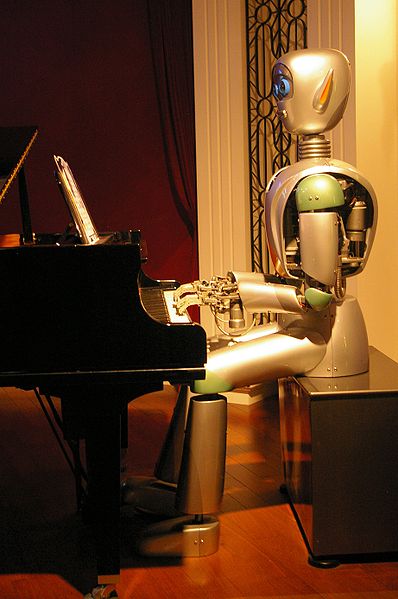
Back to homepage
Introduction

Robot playing piano in Shangai museum. (Wikimedia Commons)
Having made a few simple robots myself, I was quickly bored by their predictable pre-programmed behaviour.
While fully pre-programmed electromechanical helper might still be useful for many situations,
really interesting animal-like or human-like intelligence can only come from learning.
This was proven by many failures of early "AI" research in 1960s and 1970s,
where computer programs tended to become unmanageably complex yet they still could not reason at the level
of a four-year old, especially about the (to us) commonplace knowledge.
Their learning was almost non-existent. Latter years brought return to
some basic starting points, and some progress was made.
I therefore became interested in other prospects to create real AI, especially building of physical models
to validate different hypoteses about nervous systems.
Some early pioneers in this field were William Grey Walter,
who built turtle robots in 1940s and 1950s, and William Ross Ashby
(books freely available online),
who built homeostat at around the same time.
One of interesting developments are Darwin
robots with evolving neural nets built at The
Neurosciences Institute at San Diego.
The other one is AI work with neural networks done by very unique Steve Grand.
I highly recommend his book "Creation: Life and how to make it".
Personal thoughts about AI
I will use this page as a collection point for various online resources, and to write down any thoughts about the
AI development that I consider to be important or interesting.
I do hope to produce something useful in this area eventually.
It is interesting to note that Grey Walter robot designs used only 3 vacuum tubes,
yet they were able to exibit a range of different "behaviours", thanks to ingenious connections between them.
He claimed that number of interconnections actually determines the number of possible states,
not the number of active elements.
Ross Ashby pointed out that:
1. it is the environment that programs the living beings, and
2. lacking enough genes to develop fully developed brain abilities, our brains initially provide only the basic
learning framework, and all higher human abilities are developed from learning.
It cannot be otherwise.
Therefore, real intelligence must learn from basic principles.
It cannot be fully pre-programmed or "just appear full blown at the flick of a switch like Athena
from a head of Zeus".
What must and can be done is to somehow "program" the learning ability, and then allow the robot
to explore and learn.
Quotes
William Ross Ashby:
"The scientist does not believe in events without causes, not even when they happen in the brain."
"Disorder never proceeds to order so milk can never separate into buttermilk and cream."
"The drive to equilibrium forces the emergence of intelligence."
"The rule for decision is: Use what you know to narrow the field as far as possible:
after that, do as you please."
"Any system that achieves appropriate selection (to a degree better than chance)
does so as a consequence of information received."
"No system adapts to the changing: it can adapt only to what is constant."
"Only the environment can design a brain."
"The error-controlled servo-mechanism is a brain without eyes."
... machines with feedback are not subject to the oft-repeated dictum that machines must act
blindly and cannot correct their errors.
Such a statement is true of machines without feedback, but not of machines in general ...
Useful links
Darwin series of autonomous vehicles with large neural nets (papers in
pdf format):
http://vesicle.nsi.edu/nomad/pubs.html
and http://vesicle.nsi.edu/nomad/index.html
William Ross Ashby digital archive (two books and other documents in pdf format):
http://www.rossashby.info/index.html
Back to homepage

